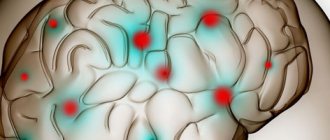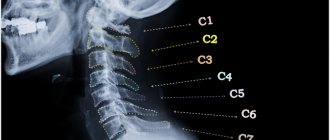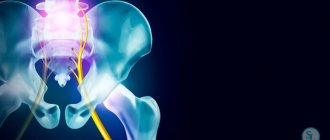Vertebrogenic cervicalgia is a common pathology among middle-aged people engaged in sedentary mental work. Prolonged tension in the muscles of the neck and collar area provokes the development of pathologies of the spinal column. These, in turn, cause severe pain.
In this article you can find out more information about the symptoms and treatment of vertebrogenic cervicalgia, and understand the potential causes of the development of this disease. This information will help you make the right decision about effective and safe treatment. You will also be able to independently recognize the first signs of trouble and seek medical help in time.
Acute vertebrogenic cervicalgia is the primary appearance of pain in the neck and collar area. It can occur after a long static position of the body and head, an incorrectly chosen position for night sleep, traumatic effects on the spinal column, etc. If within 5 - 7 days this syndrome does not go away completely, then doctors talk about the disease becoming chronic. currents.
Chronic vertebrogenic cervicalgia has an undulating course. Periods of remission (complete absence of symptoms) are followed by exacerbations (with severe pain and limited mobility). Official medicine is able to offer patients with this pathology only symptomatic treatment. During an exacerbation, non-steroidal anti-inflammatory drugs are prescribed in combination with muscle relaxants. This allows the period of remission to return and the patient can begin his work. But the cause of the pathology does not disappear at this time and destructive processes continue.
It is important to understand that vertebrogenic cervicalgia syndrome is secondary. In the foreground, such patients always have a chronic disease of the musculoskeletal system. Most often these are degenerative dystrophic changes in the cartilaginous tissues of the intervertebral discs. Osteochondrosis can provoke the development of protrusion, extrusion and intervertebral hernia - these conditions also lead to cervicalgia. The negative impact of rheumatic and post-traumatic deformities cannot be ruled out.
To begin treatment of vertebrogenic cervicalgia, it is necessary to carry out a full differential diagnosis, the doctor must establish the potential cause of the development of pain and correct this condition by available means. Then work is carried out to restore the functionality of the muscles of the neck and collar area, improve the processes of nerve impulses, etc.
If you notice the first signs of vertebrogenic cervicalgia, do not self-treat under any circumstances. Do not use analgesic drugs or ointments. This will only worsen the health of your spinal column. Seek medical help from a vertebrologist or neurologist. These doctors have sufficient professional competence to make an accurate diagnosis and prescribe adequate and safe treatment for the patient’s health.
In Moscow, you can make a free appointment with a vertebrologist and neurologist at our manual therapy clinic. Experienced doctors work here. They will conduct a full examination and give you a preliminary diagnosis. You will then be given individual recommendations for further examination and treatment. To register, use the special form located further on the page.
Causes of cervicalgia syndrome of vertebrogenic origin
Vertebrogenic moderate cervicalgia can appear in completely healthy people under the influence of a number of pathogenic factors. For example, prolonged work at a computer with excessive tension in the muscles of the neck and collar area can cause spasm of myocytes, which will lead to severe pain. However, this condition is different in that it goes away completely on its own (without the use of medications) within a few hours.
Similar manifestations may appear after visiting a bathhouse or sauna, exposure to a draft, emotional stress, etc.
True cervicalgia syndrome of vertebrogenic origin is always a complication of diseases of the tissues of the spinal column. Potential causes include the following pathologies:
- cicatricial deformation of the ligamentous and tendon apparatus after multiple injuries (for example, sprains and ruptures);
- degenerative dystrophic changes in the cartilage tissues of the intervertebral discs (osteochondrosis);
- complications of long-term osteochondrosis, such as protrusion (decrease in the height of the intervertebral disc), extrusion (rupture of the fibrous ring) and intervertebral hernia (exit of part of the nucleus pulposus through the rupture);
- deforming osteoarthritis of the uncovertebral, facet and facet joints in the cervical spine;
- instability of the position of the vertebral bodies, their dislocations and subluxations, displacements such as antelesthesis and retrolisthesis;
- curvature of the spinal column, including in the thoracic region with compensatory displacement of the vertebrae in the neck;
- consequences of injuries in the form of cracks and fractures of the bone tissue of the vertebral bodies and their processes;
- rheumatoid processes such as systemic lupus erythematosus, ankylosing spondylitis, scleroderma, etc.
In old age, vertebrogenic cervicalgia is a consequence of the destruction of bone tissue (osteoporosis). The vertebral bodies sag, the length of the spinal canal decreases. This leads to compression of the hard membranes of the spinal cord, narrowing of the foraminal openings through which the radicular nerves depart.
The development of vertebrogenic cervicalgia syndrome can be triggered by emotional shock, muscle inflammation and a deficiency of certain microelements responsible for the transmission of nerve impulses.
Treatment of vertebrogenic cervicalgia
Cervicalgia is mainly treated with conservative methods. It is also worth eliminating not only the pain, but also the disease that causes it. Treatment is prescribed after a complete diagnosis and may vary significantly.
There are 4 main methods of conservative treatment of vertebrogenic cervicalgia:
- Therapeutic gymnastics is one of the key methods of combating such pain syndromes, but it is recommended to begin a course of exercise therapy after the pain has subsided;
- Taking muscle relaxants - this type of medication relaxes the muscles if a spasm occurs when pain occurs;
- Painkillers and non-steroidal anti-inflammatory drugs - this group of drugs relieves pain, swelling and inflammation;
- Wearing a cervical collar - should be used after consultation with a specialist, who should indicate the wearing time;
- Traction treatment is prescribed to reduce pain.
Clinical symptoms of vertebrogenic cervicalgia
The clinical picture develops very acutely. Severe cramping pain appears in the neck and collar area. It worsens when trying to make any movements with the head and hands.
Gradually, the symptoms of vertebrogenic cervicalgia subside, but when you try to turn your head or throw it back, they reappear. Other signs of the disease include:
- excessive tension in the muscles of the neck and collar area;
- impaired mobility, feeling of stiffness of movements;
- muscle tension headache;
- pain in the back of the head and temples;
- difficulty making hand movements;
- decreased muscle strength in the upper extremities;
- the appearance of a periodic sensation of complete loss of sensitivity in one or another part of the hand;
- dizziness, nausea, flickering before the eyes or the appearance of a veil (these are signs of impaired blood flow in the posterior vertebral arteries, which leads to a reduction in the volume of blood flowing to the brain).
Gradually, the symptoms of vertebrogenic cervicalgia become less pronounced. But this does not mean a sweaty recovery. On the contrary, pathological changes continue to develop in cartilage, tendon, muscle and ligament tissues. Scar deformation further aggravates the patient's condition. Over a long period of time, vertebrogenic cervicalgia leads to significant impairment of cerebral circulation. This is fraught with the development of a stroke with subsequent paralysis of the body. Patients may experience depression, depression, and decreased mental and physical performance.
Diagnosis is carried out by a vertebrologist or neurologist. First, the condition of the cervical spine is examined and determined. Then an x-ray of the cervical spine is taken in different projections. This allows us to determine the condition of the vertebral bodies and the height of the intervertebral spaces. If it is difficult to make an accurate diagnosis, the doctor may recommend an MRI or CT examination. To assess the intensity of cerebral circulation, an ultrasound scan of the vessels of the neck and head is performed.
Causes of cervicalgia
There are two main types of disease: vertebrogenic cervicalgia, the cause of which is associated with damage to the cervical spine, and non-vertebrogenic, which is based on damage to the muscles, ligaments, and nerves in the neck.
Vertebrogenic cervicalgia can result from diseases such as herniation or protrusion of the intervertebral disc, rheumatoid arthritis, spondylosis, osteoarthritis, trauma to the cervical spine, or a tumor in this area.
Cervical cervicalgia of a non-vertebrogenic nature can be a consequence of diseases such as myositis of the occipital muscles, sprain or muscle sprain or subluxation in the neck, neuritis of the occipital nerve, as well as psychogenic causes of development.
The inflammatory process can be localized in the area of the dura mater (meningitis), in the area of the epidural space (between the vertebrae and the dura mater), and may also result from hemorrhage under the arachnoid membrane. Damage to the vertebral artery, such as its dissection or thrombosis, is one of the causes of cervicalgia.
Factors that provoke the development of cervicalgia will be: uncomfortable posture during sleep, performing static work with a load in the cervical-collar area, infections, both in the spine and in other areas of the human body.
Cervicalgia syndrome is a symptom complex that includes limited mobility in the cervical spine, pain in the back of the head, numbness or a tingling sensation (“pins and needles”) in the fingers, as well as dizziness and tinnitus.
Cervicalgia can have a chronic course with long-term causative diseases, the presence of provoking factors, as well as severe clinical symptoms.
Complications of vertebrogenic cervicalgia
As vertebrogenic cervicalgia develops, complications arise. The most dangerous to human health is vertebrogenic cervicalgia with muscular-tonic syndrome - this condition can provoke cerebrovascular accident. In the early stages, this leads to vegetative-vascular dystonia. Blood pressure may increase and mental performance may decrease. In a later period, this leads to serious arterial hypertension. There is a high probability of developing acute cerebrovascular accident (stroke) and body paralysis.
An increase in muscle tone has a negative effect on blood microcirculation and diffuse nutrition of the cartilage tissue of the intervertebral discs. Therefore, with vertebrogenic cervicalgia, all intervertebral discs are often quickly destroyed and widespread osteochondrosis of the cervical spine occurs.
Another common complication of vertebrogenic cervicalgia is thoracalgia (pain in the chest area). Often it imitates a heart attack or angina. A diagnosis of thoracic osteochondrosis, intercostal neuralgia, etc. may be erroneously made.
Treatment
Treatment should be comprehensive, as is the treatment of any problem with the spine. Depending on the severity of the muscular-tonic syndrome (the leading pathological mechanism for the development of headaches is myofascial - tension in the muscles and fascia of the tendon helmet of the head), the required dosage of muscle relaxants (mydocalm, baklosan, sirdalud) is prescribed. Muscle relaxants are usually prescribed for a period of 2 weeks to one month.
Effective anti-inflammatory therapy is also necessary, which may include various drugs (diclofenac, ketonal, meloxicam, Celebrex, Airtal and others). You should remember the need to protect the gastrointestinal tract if there is a risk of developing gastropathy. Anti-inflammatory therapy should last at least 3-5 days, but not exceed two weeks due to the risk of developing complications from the stomach and other organs of the gastrointestinal tract.
The third main point in the treatment of cervicocranialgia is neuroprotective therapy, which most often includes B vitamins (combilipen, milgamma, unigamma and others). Neuroprotective therapy should continue after acute symptoms have resolved. In the acute period, it is recommended to use diadynamic currents in combination with exercise therapy for stretching.
How to treat vertebrogenic cervicalgia
Treatment of vertebrogenic cervicalgia can only be complex. First of all, all potential causes should be eliminated. It is impossible to treat this condition separately, since in most cases vertebrogenic cervicalgia is closely associated with damage to the tissues of the spinal column. If they are not eliminated, the pain and all the unpleasant symptoms will return again.
Therefore, before treating vertebrogenic cervicalgia, an experienced doctor will collect a detailed history and give the patient individual recommendations. They may include changing your lifestyle, introducing the habit of doing physical exercise, eating right, giving up bad habits, properly organizing your sleeping and working space, etc.
For the treatment of vertebrogenic cervicalgia, the use of pharmacological drugs is completely inappropriate. There are no drugs that would be able to restore damaged tissue and eliminate the negative effects on the hard membranes of the spinal cord and radicular nerves.
Manual therapy methods provide positive results. In our clinic, the course of treatment is developed individually for each patient and may include:
- manual traction of the spinal column in the cervical region (allows you to increase the height of the intervertebral spaces and eliminate the compression effect on the radicular nerves and hard shells of the spinal cord);
- osteopathy, which enhances the processes of microcirculation of blood and lymphatic fluid in the affected areas;
- massage, which allows you to eliminate increased muscle tone and restore their normal performance;
- physiotherapy, which accelerates metabolic processes at the cellular level;
- reflexology, which triggers tissue regeneration processes by using the body’s hidden reserves;
- laser exposure, therapeutic exercises, kinesiotherapy and much more.
If you need treatment for vertebrogenic cervicalgia, then you can make an initial free appointment with a vertebrologist in our manual therapy clinic right now. During the initial consultation, the doctor will make an accurate diagnosis and give all the necessary individual recommendations for comprehensive treatment.
Diagnosis of vertebrogenic cervicalgia
To carry out a successful diagnosis, you should contact competent specialists because the most accurate anamnesis and clinical tests are necessary. You need to remember when and under what circumstances the pain first appeared. Was it hypothermia, pain after sleep or during heavy physical work.
Next, the specialist will prescribe a set of tests, which usually include:
- X-ray examination of the cervical spine;
- MRI (magnetic resonance imaging);
- CT (computed tomography).
Sometimes doctors prescribe additional examinations, for example, CT in combination with myelography - a similar diagnosis is used for postoperative patients.
Vertebrogenic cervicocranialgia
Cranialgia refers to headaches localized in the lower part of the back of the head (“cranio” in Latin means “skull”), often accompanied by compression of the nerve roots. “Cervico” is a prefix referring to the neck, “vertebro” is everything connected with the spine. That is, vertebrogenic cervicocraniaglia is a headache caused by pain or other unpleasant sensations in the cervical area, caused by diseases or pathologies of the spine.
Specific headaches in the skull are caused by disturbances in the passage of nerve impulses along the fibers or insufficient blood supply to certain areas of the brain, which can cause increased intracranial pressure and severe pain. Treatment of headaches of this etiology requires a special approach; conventional analgesic drugs, as a rule, do not bring patients the expected relief.
Cranialgia can cover only the occipital part of the head or spread to the temples, parietal region or frontal region, in some cases it manifests itself unilaterally. The nature of the pain is also different: it can be bursting and pressing, chronic or sharp, paroxysmal with spasms and burning. Quite often accompanied by dizziness, nausea, loss of coordination, limited neck mobility, impaired hearing and vision, muscle weakness or numbness of the upper extremities. It intensifies with physical exertion, sudden movements, hypothermia, and prolonged stay in forced positions.
Reasons for the development of the disease
Most often, vertebrogenic cervicocranialgia is preceded by the development of osteochondrosis (a disease of the spine in which the intervertebral discs wear out). A sedentary, inactive lifestyle of modern life, bad habits and unfavorable ecology gradually have a detrimental effect on cartilage tissue. The walls of the discs begin to crack and wear out, and the gelatinous substance inside begins to lose moisture. The spine becomes less and less mobile, flexible and is no longer able to withstand the previous loads.
For a long time, the symptoms of cervical osteochondrosis may practically not bother patients and attract attention with severe pain already in advanced stages, when a protrusion or herniation of the intervertebral disc has formed.
Similar manifestations (gradual wear and aging of the anatomical structures of the disc, degeneration of the outer fibers, pathological changes in the longitudinal ligaments, proliferation of osteophytes) are also observed in spinal spondylosis, the treatment of which is carried out mainly in older people. In addition, the development of cranialgia can be caused by traumatic injuries to the spine or nearby soft tissues.
Flattening of the vertebral discs, the growth of osteophytes (bone growths), the formation of vertebral hernias provokes compression of the nerve roots emerging from the spinal cord (radicular syndrome), blood vessels located in the neck (vertebral artery syndrome or hypertensive syndrome - difficulty in the outflow of venous blood from the brain) , and this in turn brings patients to the headache clinic.
Manifestations of cervicocranialgia
The manifestations of the symptoms of the disease depend entirely on the affected areas. So, for example, with compression of the cervical, occipital or facial nerve endings, the nature of the pain is acute, shooting, usually one-sided. Dizziness and nausea are usually not observed; there may be difficulties with speech and swallowing. Cranialgia intensifies even with minor physical exertion and subsides slightly at rest.
Insufficient blood supply to the vessels of the brain (vertebrobasilar insufficiency) with vertebral artery syndrome has cerebral paroxysmal symptoms. Painful sensations cover the back of the head, crown, temporal lobes, eyes, and are pulsating and burning in nature. Accompanied by dizziness, a feeling of rotation of the surrounding world or the person himself, nausea, vomiting, hearing and vision disorders (tinnitus, darkening in the eyes or flickering “butterflies”, pulsating in the temples). The patient is irritated by bright lights and noise.
Similar bilateral manifestations also occur with hypertensive syndrome, only the nature of the pain is bursting and pressing with an increase in intracranial pressure and/or blood pressure. In all cases, anxiety, insomnia, lacrimation, burning in the parietal region, redness of the skin of the face and eyes are noted.
Thus, for the correct diagnosis of the causes of vertebrogenic cervicocranialgia and adequate treatment, the patient must carefully differentiate the symptoms that arise and the nature of their changes and report them to the attending physician at the headache center when collecting an anamnesis.
Treatment of cranialgia
To establish a final diagnosis, the attending physician will prescribe an x-ray to the patient; if more detailed data is needed, a computed tomography or MRI scan of the spine or brain tomography may be prescribed. The condition of the blood vessels, the direction, intensity and speed of passage of blood fluid through them will be shown by Doppler ultrasound. It will be necessary to undergo general clinical and laboratory tests and have a cardiogram done.
headache treatment will be comprehensive, aimed at eliminating spinal pathologies and relieving pain. When nerve roots are compressed, anti-inflammatory drugs and agents that improve the conductivity of nerve fibers, neuroprotectors, and B vitamins are prescribed. Factors associated with blood vessels will be eliminated by vasodilators that improve blood circulation and the outflow of venous blood.
In the initial acute period, muscle relaxants and/or local anesthetic blockades (lidocaine or novocaine) can be prescribed to relieve pain in the neck and soft tissue spasms. A good healing effect during all periods of treatment is provided by manual therapy sessions (massage, reflexology and relaxation therapy, acupuncture, etc.), physiotherapy (swimming, exercise therapy, electrophoresis, shock wave therapy, etc.).
Self-treatment of vertebrogenic cervicocraniology with painkillers, anti-inflammatory and antispasmodic drugs, as a rule, does not bring patients the expected relief, since only pain is relieved, but not the causes of its occurrence.
Competent treatment can only be prescribed by a highly qualified doctor if the results of all the necessary studies are available. Author: K.M.N., Academician of the Russian Academy of Medical Sciences M.A. Bobyr
Carrying out diagnostics
Doctors conduct a full examination of the patient to determine the real causes of cervicocranialgia, using the following techniques:
- Questioning the patient, identifying the nature of the course of the disease.
- X-ray of the cervical region in several projections.
- General biochemical blood test.
- Magnetic resonance and computed tomography.
- Electromyography (additional diagnostic procedures).
Only after all the examinations have been completed, the doctor can make the correct diagnosis and prescribe effective treatment. Self-administration of medications is fraught with negative consequences due to possible intolerance to certain components.
Exercise therapy recommendations
As a preventative measure, you should engage in physical therapy aimed at strengthening the muscular corset of the cervical spine. The massage technique for vertebrogenic cervicocranialgia should include a long preparatory process (stroking and rubbing), while kneading is almost not carried out. It is better and more effective to use acupressure and other manual techniques on the scalp area - after all, relaxation of the tendon helmet can provide quick and pronounced relief.
Important! The persistence of headaches after complex treatment of vertebrogenic cervicocranialgia and relief of muscle tension in the collar zone and pain in the cervical spine should be a reason to begin a diagnostic search for another cause of the cephalgic syndrome.










